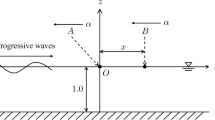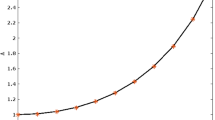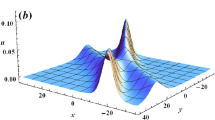Abstract
A new 2D numerical model to predict the underwater acoustic propagation is obtained by exploring the potential of the Partition of Unity Method (PUM) enriched with plane waves. The aim of the work is to obtain sound pressure level distributions when multiple operational noise sources are present, in order to assess the acoustic impact over the marine fauna. The model takes advantage of the suitability of the PUM for solving the Helmholtz equation, especially for the practical case of large domains and medium frequencies. The seawater acoustic absorption and the acoustic reflectance of the sea surface and sea bottom are explicitly considered, and perfectly matched layers (PML) are placed at the lateral artificial boundaries to avoid spurious reflexions. The model includes semi-analytical integration rules which are adapted to highly oscillatory integrands with the aim of reducing the computational cost of the integration step. In addition, we develop a novel strategy to mitigate the ill-conditioning of the elemental and global system matrices. Specifically, we compute a low-rank approximation of the local space of solutions, which in turn reduces the number of degrees of freedom, the CPU time and the memory footprint. Numerical examples are presented to illustrate the capabilities of the model and to assess its accuracy.












Similar content being viewed by others
References
Nedwell JR, Langworthy J, Howell D (2003) Assessment of sub-sea acoustic noise and vibration from offshore wind turbines and its impact on marine wildlife; initial measurements of underwater noise during construction of offshore windfarms, and comparison with background noise, Subacoustech Report ref: 544R0424, published by COWRIE
Ainslie MA, de Jong CAF, Dol HS, Blaquière G, Marasini C (2009) Assessment of natural and anthropogenic sound sources and acoustic propagation in the North Sea. TNO report TNO-DV, p. C085
Thomsen F, Lüdemann K, Kafemann R, Piper W (2006) Effects of offshore wind farm noise on marine mammals and fish. Biola, Hamburg, Germany on behalf of COWRIE Ltd, p. 62
Thomsen F (2009) Assessment of the environmental impact of underwater noise. OSPAR Commission. Biodiversity Series, vol. 436
Southall BL, Bowles AE, Ellison WT, Finneran JJ, Gentry RL, Greene CL Jr, Kastak D, Ketten DR, Miller JH, Nachtigall PE, Richardson WJ, Thomas JA, Tyack PL (2007) Marine mammal noise exposure criteria: initial scientific recommendations. Aquat Mamm 33(4):411–521
Marine Mammal Commission (1972) ‘The Marine Mammal Protection Act of 1972
OSPAR Commission (1992) Convention for the Protection of the Marine Environment of the North-East Atlantic. Sintra
European Commission (2008) Directive 2008/56/EC establishing a framework for community action in the field of marine environmental policy (Marine Strategy Framework Directive). European Parliament and Council
Dekeling RPA, Tasker ML, Ainslie MA, Andersson M, Andr M, Castellote M, Borsani JF, Dalen J, Folegot T, Leaper R, Liebschner A, Pajala J, Robinson SP, Sigray P, Sutton G, Thomsen F, Van der Graaf AJ, Werner S, Wittekind D, Young JV (2013) Monitoring guidance for underwater noise in European seas. Second Report of the technical subgroup on underwater noise (TSG Noise)
Hazelwood RA, Connelly J (2005) Estimation of underwater noise—a simplified method. Int J Soc for Underw Technol 26(3):51–57
Tappert FD (1977) The parabolic approximation method, vol. 70. Lecture Notes in physics, Courant Institute of Mathematical Sciences, New York University: Springer, chap 5, pp 224–287
Collins MD (1993) A split-step Padé solution for the parabolic equation method. J Acoust Soc Am 93:1736–1742
Babuška I, Sauter SA (1997) Is the pollution effect of the FEM avoidable for the Helmholtz equation considering high wave numbers? SIAM J Numer Anal 34:2392–2423
Ihlenburg F (1998) Finite element analysis of acoustic scattering, vol. 132 of applied mathematical sciences, 1st edn. Springer-Verlag, New York
Deraemaeker A, Babuška I, Bouillard P (1999) Dispersion and pollution of the FEM solution for the Helmholtz equation in one, two and three dimensions. Int J Numer Methods Engrg 46:471–499
Melenk JM (1995) On Generalized Finite Element Methods. PhD thesis, The University of Maryland
Melenk JM, Babuška I (1996) The partition of unity finite element method: basic theory and applications. Comput Methods Appl Mech Eng 139:289–314
Babuška I, Melenk JM (1997) The partition of unity method. Int J Numer Methods Engrg 40:727–758
Herrera I, Sabina FJ (1978) Connectivity as an alternative to boundary integral equations: construction of bases. Proc Natl Acad Sci USA 75:2059–2063
Perrey-Debain E, Laghrouche O, Bettess P, Trevelyan J (2004) Plane-wave basis finite elements and boundary elements for three-dimensional wave scattering. Phil Trans R Soc Lond A 362:561–577
Wang D, Tezaur R, Toivanen J, Farhat C (2012) Overview of the discontinuous enrichment method, the ultra-weak variational formulation, and the partition of unity method for acoustic scattering in the medium frequency regime and performance comparisons. Int J Numer Methods Eng 89:403–417
Cessenat O, Després B (1998) Application of an ultra weak variational formulation of elliptic PDEs to the two-dimensional Helmholtz problem. SIAM J Numer Anal 35:255–299
Huttunen T, Monk P, Kaipio JP (2002) Computational aspects of the ultra-weak variational formulation. J Comput Phys 182:27–46
Farhat C, Harari I, Franca LP (2001) The discontinuous enrichment method. Comput Methods Appl Mech Eng 190:6455–6479
Farhat C, Harari I, Hetmaniuk U (2003) A discontinuous Galerkin method with Lagrange multipliers for the solution of Helmholtz problems in the mid-frequency regime. Comput Methods Appl Mech Eng 132:1389–1419
Babuška I, Ihlenburg F, Paik ET, Sauter SA (1995) A generalized finite element method for solving the Helmholtz equation in two dimensions with minimal pollution. Comput Methods Appl Mech Eng 128:325–359
Mayer P, Mandel J (1997) The finite ray element method for the Helmholtz equation of scattering: first numerical experiments. University of Colorado at Denver, Center for Computational Mathematics, Denver
Laghrouche O, Bettess P (2000) Short wave modelling using special finite elements. J Comput Acoust 8(1):189–210
Ortiz P, Sanchez E (2001) An improved partition of unity finite element model for diffraction problems. Int J Numer Methods Eng 50:2727–2740
Laghrouche O, Bettess P, Astley RJ (2002) Modelling of short wave diffraction problems using approximating systems of plane waves. Int J Numer Methods Eng 54:1501–1533
Laghrouche O, Bettess P, Perrey-Debain E, Trevelyan J (2003) Plane wave basis finite-elements for wave scattering in three dimensions. Commun Numer Meth Eng 19:715–723
Ortiz P (2004) Finite elements using a plane-wave basis for scatering of surface water waves. Phil Trans R Soc Lond A 362:525–540
Laghrouche O, Bettess P, Perrey-Debain E, Trevelyan J (2005) Wave interpolation finite elements for Helmholtz problems with jumps in the wave speed. Comput Methods Appl Mech Eng 194:367–381
De Bel E, Villon P, Bouillard P (2005) Forced vibrations in the medium frequency range solved by a partition of unity method with local information. Int J Numer Methods Eng 62:1105–1126
Strouboulis T, Hidajat R (2006) Partition of unity method for Helmholtz equation: q-convergence for plane waves and wave-band local bases. Appl Math 51(2):181–204
Bettess P, Shirron J, Laghrouche O, Peseux B, Sugimoto R, Trevelyan J (2003) A numerical integration scheme for special finite elements for the Helmholtz equation. Int J Numer Methods Eng 56:531–552
Sugimoto R, Bettess P, Trevelyan J (2003) A numerical integration scheme for special quadrilateral finite elements for the Helmholtz equation. Commun Numer Meth Eng 19:233–245
Kuperman WA, Lynch JF (2004) Shallow-water acoustics. Phys today 57:55–61
European Wind Energy Association (EWEA) and others (2013) Deep water—the next step for offshore wind energy. Brussels: A report by the European Wind Energy Association 2013
Ainslie MA, McColm JG (1998) A simplified formula for viscous and chemical absorption in sea water. J Acoust Soc Am 103:1671–1672
Wong GSK, Zhu S (1995) Speed of sound in seawater as a function of salinity, temperature, and pressure. J Acoust Soc Am 97:1732–1736
Chen C-T, Millero FJ (1977) Speed of sound in seawater at high pressures. J Acoust Soc Am 62:1129–1135
Leroy CC, Parthiot F (1998) Depth-pressure relationships in the oceans and seas. J Acoust Soc Am 103:1346–1352
Isaacson M, Qu S (1990) Waves in a harbour with partially reflecting boundaries. Coast Eng 14:193–214
Berkhoff JCW (1976) Mathematical models for simple harmonic linear water waves. Wave diffraction and refraction. PhD thesis, TU Delft, Delft, Nederlands
Urick RJ (1983) Principles of underwater sound, 3rd edn. Peninsula Publishing, Los Altos
Burdic WS (1983) Underwater acoustic system analysis. Prentice-Hall signal processing series, Prentice-Hall Inc., London
Rappaport CM (1995) Perfectly matched absorbing boundary conditions based on anisotropic lossy mapping of space. IEEE Microw Guided Wave Lett 5:90–92
Bérenger J-P (1994) A perfectly matched layer for the absorption of electromagnetic waves. J Comput Phys 114:185–200
Johnson SG (2007) Notes on Perfectly Matched Layers (PMLs). Notes for MIT courses 18.369 and 18.336
Kinsler LE, Frey AR, Coppens AB, Sanders JV (2000) Fundamentals of acoustics, 4th edn. Wiley, New York
Strouboulis T, Babuška I, Hidajat R (2006) The generalized finite element method for Helmholtz equation: theory, computation, and open problems. Comput Methods Appl Mech Eng 195:4711–4731
Strouboulis T, Hidajat R, Babuška I (2008) The generalized finite element method for Helmholtz equation. Part II: effect of choice of handbook functions, error due to absorbing boundary conditions and its assessment. Comput Methods Appl Mech Eng 197:364–380
Acknowledgments
This work is partially supported by KIC InnoEnergy and European Institute of Innovation and Technology (EIT) through project Offshore Test Station (OTS; 03_2011_LH03 Industry Energy Efficiency).
Author information
Authors and Affiliations
Corresponding author
Appendices
Appendix 1: Seawater absorption
In this appendix we deduce the relation between the absorption coefficient \(\alpha \) and the imaginary part of the complex wavenumber \(k_2\), see Eq. (7). The value of the seawater absorption coefficient \(\alpha \) strongly depends on the frequency, but also on the temperature, the salinity, the hydrostatic pressure (depth) and the acidity. Our model estimates the coefficient by means of the Ainslie and McColm formula [40]:
where
is the boron acid relaxation frequency in kHz,
is the magnesium sulfate relaxation frequency in kHz, \(\alpha \) is the absorption coefficient in dB/km, f is the frequency in kHz, T is the seawater temperature in \(^\circ \)C, S is the salinity in ppt, d is the depth in km, and pH is the measure of the acidity.
If part of data is missing, Eq. (26) can be replaced by
that considers the average conditions at the ocean surface: T = 17 \(^\circ \)C, S = 35 ppt, and d = 0 km and pH = 8. Figure 13 shows the dependence of the absorption coefficient with the frequency according to Eq. (27). Note that the absorption is specially significant for frequencies above a few kHz, and that can be neglected for short and mid-range propagations at low frequency.
Once the absorption coefficient \(\alpha \) is computed using Eqs. (26) or (27), it is included in our model via the the imaginary part of the complex wavenumber \(k_2\). Given a plane wave with an arbitrary amplitude A, propagating in a free space following an arbitrary direction vector \(\varvec{e}\), it suffers an exponential decay determined by \(k_2\),
Thus, and according to Eqs. (1) and (28), the transition loss between two points separated by a distance r (in km) produced exclusively by the physical absorption is:
and Eq. (7) follows.
Appendix 2: Transmission coefficient
In this appendix we relate the transmission coefficient \(\tau \) appearing in the Robin boundary condition (3) with several material properties of the surrounding media (air and sea bottom). The transmission coefficient can be written as [45]:
where \(i=\sqrt{-1}\) is the imaginary unit,
and
being \(K_r\) the reflection coefficient, which is the ratio between the reflected and the incident wave amplitudes \(K_r = |p_r|/|p_i|\), \(\beta \) the reflection phase angle, and \(\gamma \) the incident wave direction relative to the normal at the boundary.
The reflection phase angle \(\beta \) is set to zero, considering that the position of the numerical boundary agrees with its actual position. Thus, the complex transmission coefficient is purely imaginary. In addition, the incident wave direction \(\gamma \) cannot be unambiguously specified since the full-wave approach implies multiple reflections with different wave incident directions angles. In our model we conservatively assume normal incidence (\(\gamma =0\)). This is conservative in the sense that the produced noise level is going to be larger than the actual one. Thus,
The value of the transmission coefficient \(K_r\) can be obtained either from the value of the transmission loss at the interface \(\text {TL}_i\), measured in dB, or from the acoustic impedance \(Z_b=\rho _b c_b\) of the boundary, being \(\rho _b\) the density of the boundary material, depending on the availability of empirical measurements. In the first case, we have
In the second case, assuming normal incidence, we have
where \(Z_{sw} \approx 1.54 \times 10^6\) kg/(m\(^2\)s) is the acoustic impedance of the seawater. Substituting Eqs. (30) and (31) in (29) we obtain expression (8) and (9), respectively.
Rights and permissions
About this article
Cite this article
Hospital-Bravo, R., Sarrate, J. & Díez, P. Numerical modeling of undersea acoustics using a partition of unity method with plane waves enrichment. Comput Mech 57, 717–732 (2016). https://doi.org/10.1007/s00466-015-1257-8
Received:
Accepted:
Published:
Issue Date:
DOI: https://doi.org/10.1007/s00466-015-1257-8





